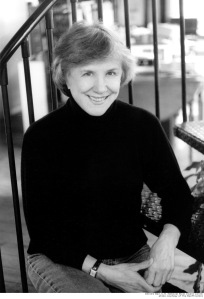 Deirdre Bair is the critically acclaimed author of five award winning biographies. She received the National Book Award for Samuel Beckett: A Biography, and her biography of Simone de Beauvoir was a finalist for the Los Angeles Times Book Prize and was chosen by The New York Times as one of the “Best Books of the Year.” Bair’s biography of Saul Steinberg, published by Nan A. Talese at Doubleday on November 20th, has met with outstanding reviews. Publisher’s Weekly states, “The pre-eminent New Yorker cartoonist leads a life worthy of his own ironic art in this scintillating biography.”
Deirdre Bair is the critically acclaimed author of five award winning biographies. She received the National Book Award for Samuel Beckett: A Biography, and her biography of Simone de Beauvoir was a finalist for the Los Angeles Times Book Prize and was chosen by The New York Times as one of the “Best Books of the Year.” Bair’s biography of Saul Steinberg, published by Nan A. Talese at Doubleday on November 20th, has met with outstanding reviews. Publisher’s Weekly states, “The pre-eminent New Yorker cartoonist leads a life worthy of his own ironic art in this scintillating biography.”
The following is an excerpt from an interview conducted by WNBA-NYC President Jane Kinney-Denning, and originally published in the New York Bookwoman. In this interview, Ms. Bair, a member of the NYC chapter of the WNBA, shares some of her stories and insights on writing about Saul Steinberg, and tells us a little bit about what she is working on next.
***
Thank you, Deirdre, for agreeing to do this interview. I am thrilled that another one of your biographies was recently published. I am always amazed by the depth and breadth of your biographies, so, to start this interview, I thought I would ask you how you prepare yourself to write about the life of another person. Are there certain stages that you go through during the writing process?
It’s difficult to answer your question because the life of every person I have written about was so different from the others that each book required its own specific technique. For some books, I felt I had to complete the research before I could even think about starting to write; for others I wrote certain passages that seemed alive and fresh to me at the time, and almost always, I had to rewrite them because subsequent research proved that they needed some degree of moderation, if not almost total change. I suppose the short answer is that I try to know as much about the subject’s life as possible so that when I am starting to write it, I can structure all my responses to various parts of it accordingly.
What was it in particular about Steinberg’s life and work that drew you to write his first biography? Why did you think it was important for his story to be told?
Like many other Americans in the last half of the twentieth century, I grew up eagerly awaiting the arrival of The New Yorker each week. Back when there was no table of contents, I think a lot of people must have done what I did, to flip through the pages scanning the titles of articles and glancing at the end to see who wrote them while giving my initial attention to the drawings and cartoons. And from the quantity of fan mail the magazine received, I don’t think I was the only one who stopped fanning the pages to study whenever Saul Steinberg contributed to an issue. His work always got my attention, and nine times out of ten, my first response was the same puzzled question: “Just what did he mean by that?” All those numbers, letters, squiggles, and curlicues; those funny animals and ferocious figures; the brutalist buildings, tranquil landscapes, and chaotic street scenes—what was he getting at? And as for “that poster,” the iconic “View from 9th Avenue” dubbed by me and countless others “The New Yorker’s View of the World,” I am sure I was among the first delighted buyers who rushed to the store on Madison Avenue for a copy that has hung in every house I’ve lived in since then.
[…] Later, when I was packing books and files for a household move, I came across a huge folder left over from my teaching days that contained all the Steinbergiana that had adorned the walls and bulletin boards of my various offices. For the first time I was aware of the variety of his output, from The New Yorker covers to product advertisements. I had saved an old Hallmark calendar and one leftover Christmas card from those he drew for the Museum of Modern Art. There was even a photo of a funny looking fellow with a moustache and black-framed glasses holding a tiny brown paper mask over his nose that I now knew was Saul Steinberg himself. How many years had I saved all this? It was hard to remember when I started, or even why. I knew nothing about the artist’s life when I collected all these things and until that moment, had never considered finding out who he was, where he came from, or why he made such an impact upon his culture and society. At that time, I really believed that I would never write another biography, but thoughts about Saul Steinberg persisted, and almost before I could verbalize what they were, I knew that I wanted to write about him. One thing led to another, and that was the start of this biography. Several years later, the end result is here.
I understand that you just signed with Nan Talese at Random House to write your next biography on none other than Al Capone. This seems a bit of a departure from your previous work in terms of the type of person you have written about. How did doing a biography of Al Capone come about?
When I tell people I am writing about Al Capone, their faces either take on a look of sheer astonishment, or else they giggle nervously before asking the same question you have asked, that after all my more “hifalutin” subjects, how did I come to take on a Chicago gangster. The working title of the book is Al Capone: His Life and His Legacy, and here is how it started.
Last winter, a friend in the publishing world called to pick my brain. Her brother, a lawyer, represented some of the descendants of Al Capone. He told his sister that certain branches of the Capone family were distressed by some recent publications that claimed to be the “real story” about Public Enemy #1, the most famous gangster in America, and if the number of daily hits on Google search are correct, one of the most (in)famous men known throughout the world. These descendants wanted to tell the truth about Al as they knew him, and they wondered if the lawyer could help them find a writer.
Some weeks later, the family members arranged a conference call with me. None of them had any experience with writing so I listened carefully as they tried to explain what they wanted. I found myself becoming intrigued as they told me they wanted this book to happen at this particular time because the old timers in the family, those between the ages of eighty and over ninety who were alive in Al’s lifetime and knew him well, were all dying, and with them, their stories. They invited me to go to Chicago on a frigid February weekend to get to know them and to hear their stories for myself. I found myself entranced as I sat at their table, loaded with the glorious food Italian-Americans enjoy when they get together, and as I listened to their personal memories of Al, saw their photographs and other memorabilia, and heard their versions of his public life. I knew there was a book here, not only about Al’s public life but also about the private one he led in his own home and in the homes of his many relatives.
And that is why the book’s working sub-title is not only His Life but also His Legacy. I am still digesting the life histories of the Capone descendants, so different and so varied, but ultimately so fascinating. In many ways, it will be a cultural history of the Italian-American experience as well as the story of one particular family and how they have to deal with a notorious progenitor every time they give their name. It is so early in my research that, although I can think of many other things the book will become, it is too early to name them now, so I will just say it will certainly be biographical but that it will be much else besides.
The full interview was published in the New York Bookwoman, a monthly newsletter available to WNBA-NYC members.
To watch a video interview with Deirdre Bair conducted by former WNBA-NYC president, Karen Livecchia, visit WNBA-NYC’s YouTube channel.
Read a review of Deirdre’s new biography of Saul Steinberg in The New Yorker.





Wonderful interview, Jane. Deirdre’s body of work humbles this writer/member. I’m looking forward to reading her book on Capone, and I’m not usually a biography reader. Would love to have been sitting around that table in Chicgo with her.